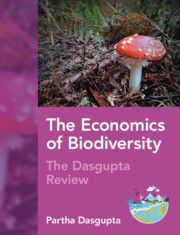Book contents
- The Economics of Biodiversity
- The Economics of Biodiversity
- Copyright page
- Contents
- List of Boxes
- Foreword
- Preface to the CUP Edition
- Preface
- Part I Foundations
- Chapter 0 How We Got to Where We Are
- Chapter 1 Nature as an Asset
- Chapter 2 Biodiversity and Ecosystem Services
- Chapter 3 Biospheric Disruptions
- Chapter 4 Human Impact on the Biosphere
- Chapter 4* The Bounded Global Economy
- Chapter 5 Risk and Uncertainty
- Chapter 6 Laws and Norms as Social Institutions
- Chapter 7 Human Institutions and Ecological Systems, 1: Unidirectional Externalities and Regulatory Policies
- Chapter 8 Human Institutions and Ecological Systems, 2:
- Chapter 8* Management of CPRs:
- Chapter 9 Human Institutions and Ecological Systems, 3:
- Chapter 10 Well-Being Across the Generations
- Introduction
- 10.1 Classical Utilitarianism
- 10.2 Utilitarian Reasoning behind the Veil of Ignorance
- 10.3 Discounting Future Generations
- 10.4 Intuitionism and Pragmatism
- 10.5 Discounting in Arbitrary Futures
- 10.6 Directives on Discounting
- 10.7 Social Rates of Return on Investment
- 10.8 Accounting Prices
- 10.9 Should Environmental Projects be Evaluated Using Lower Discount Rates?
- 10.10 The Idea of Investment
- 10.11 Population Ethics
- 10.12 The Repugnance of Existential Risks
- Annex 10.1 A Simple Exercise in Optimum Saving
- Annex 10.2 Uncertainty and Declining Discount Rates
- Annex 10.3 Three Tiers of Ethical Reasoning
- Chapter 11 The Content of Well-Being: Empirics
- Chapter 12 Valuing Biodiversity
- Chapter 13 Sustainability Assessment and Policy Analysis
- Chapter 13* Accounting Prices and Inclusive Wealth
- Part II Extensions
- Part III The Road Ahead
- Appendix
- Acronyms
- Glossary
- References
- Acknowledgements
- Author Index
- Subject Index
Annex 10.3 - Three Tiers of Ethical Reasoning
from Chapter 10 - Well-Being Across the Generations
Published online by Cambridge University Press: 10 March 2025
- The Economics of Biodiversity
- The Economics of Biodiversity
- Copyright page
- Contents
- List of Boxes
- Foreword
- Preface to the CUP Edition
- Preface
- Part I Foundations
- Chapter 0 How We Got to Where We Are
- Chapter 1 Nature as an Asset
- Chapter 2 Biodiversity and Ecosystem Services
- Chapter 3 Biospheric Disruptions
- Chapter 4 Human Impact on the Biosphere
- Chapter 4* The Bounded Global Economy
- Chapter 5 Risk and Uncertainty
- Chapter 6 Laws and Norms as Social Institutions
- Chapter 7 Human Institutions and Ecological Systems, 1: Unidirectional Externalities and Regulatory Policies
- Chapter 8 Human Institutions and Ecological Systems, 2:
- Chapter 8* Management of CPRs:
- Chapter 9 Human Institutions and Ecological Systems, 3:
- Chapter 10 Well-Being Across the Generations
- Introduction
- 10.1 Classical Utilitarianism
- 10.2 Utilitarian Reasoning behind the Veil of Ignorance
- 10.3 Discounting Future Generations
- 10.4 Intuitionism and Pragmatism
- 10.5 Discounting in Arbitrary Futures
- 10.6 Directives on Discounting
- 10.7 Social Rates of Return on Investment
- 10.8 Accounting Prices
- 10.9 Should Environmental Projects be Evaluated Using Lower Discount Rates?
- 10.10 The Idea of Investment
- 10.11 Population Ethics
- 10.12 The Repugnance of Existential Risks
- Annex 10.1 A Simple Exercise in Optimum Saving
- Annex 10.2 Uncertainty and Declining Discount Rates
- Annex 10.3 Three Tiers of Ethical Reasoning
- Chapter 11 The Content of Well-Being: Empirics
- Chapter 12 Valuing Biodiversity
- Chapter 13 Sustainability Assessment and Policy Analysis
- Chapter 13* Accounting Prices and Inclusive Wealth
- Part II Extensions
- Part III The Road Ahead
- Appendix
- Acronyms
- Glossary
- References
- Acknowledgements
- Author Index
- Subject Index
- Type
- Chapter
- Information
- The Economics of BiodiversityThe Dasgupta Review, pp. 280 - 288Publisher: Cambridge University PressPrint publication year: 2024

